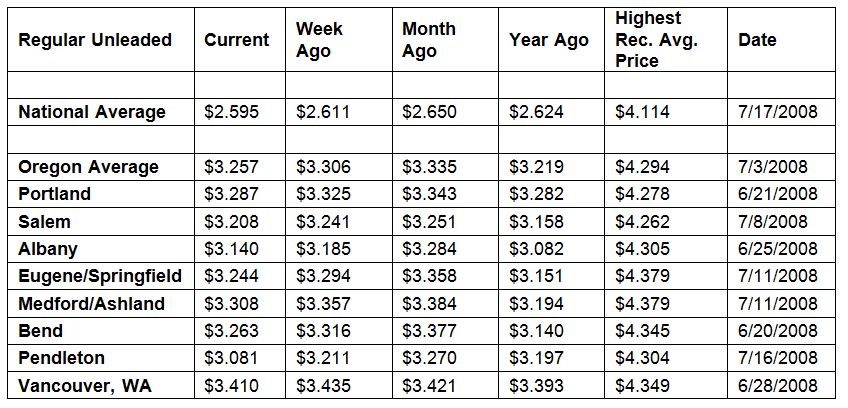Oregon and other West Coast states enjoy largest declines
PORTLAND, Ore., – Pump prices are showing little movement following the Thanksgiving holiday weekend. More than half of the states, including Oregon, are seeing prices tick down. For the week, the national average remains at $2.59 a gallon. The Oregon average dips three cents to $3.18. This is the seventh-largest weekly decline in the nation. Oregon also has the second-largest monthly decline in the nation with a drop of 16 cents.
“U.S. gasoline stocks have been growing steadily over the past few weeks and demand has started to slow, except for the bump over Thanksgiving. This trend is putting downward pressure on gas prices for the majority of drivers,” says Marie Dodds, public affairs director for AAA Oregon/Idaho.
In its latest report for the week ending Nov. 22, the U.S. Energy Information Administration (EIA) data shows a substantial 5.1 million bbl build in gasoline stocks amid flat gasoline demand.
Oregon is one of 28 states where gas prices are lower now than a week ago; As mentioned above, Oregon (-3 cents) has the seventh-largest weekly decline in the country. California (-6 cents) has the largest week-over-week decline and Utah (-3 cents) is second. Ohio (+16 cents) has the biggest weekly jump. Prices are flat in New Hampshire and New York.
This week there are six states with an average above $3 a gallon, same as a week ago. For the third week in a row, there are no states with an average above $4 a gallon. California’s average had topped the $4 mark earlier this fall.
The cheapest gas in the nation can be found in Louisiana ($2.22) and Mississippi ($2.23). For the 42nd week in a row, no states have an average below $2 a gallon.
Oregon is one of 31 states with lower prices now than a month ago. The national average is two cents less and the Oregon average is 16 cents less than a month ago. This is the second-largest monthly decrease in the nation. California (-29 cents) has the largest month-over-month decline, and Washington (-12 cents) is third. Michigan (+13 cents) has the largest month-over-month increase.
Oregon is one of 41 states where drivers are paying more than a year ago. The national average is 13 cents more and the Oregon average is six cents more than a year ago. Ohio (+47 cents) and Indiana (+31 cents) have the biggest year-over-year increases. Massachusetts (-11 cents) has the largest year-over-year drop.
West Coast
The West Coast continues to have the highest pump prices in the nation with all of the region’s states landing on the top 10 most expensive list.
| Rank | Region | Price on 12/3/19 | |
| 1 | California | $3.79 | |
| 2 | Hawaii | $3.66 | |
| 3 | Washington | $3.31 | |
| 4 | Nevada | $3.28 | |
| 5 | Oregon | $3.18 | |
| 6 | Alaska | $3.12 | |
| 7 | Idaho | $2.94 | |
| 8 | Utah | $2.92 | |
| 9 | Arizona | $2.91 | |
| 10 | Colorado | $2.81 |
California is most expensive for the 11th week in a row, with Hawaii, Washington, Nevada, Oregon, and Alaska rounding out the top six. Arizona is ninth. Oregon is fifth most expensive for the 20th week in a row.
Pump prices in the region have declined on the week, with some states seeing the largest weekly drops in the country. California (-6 cents), Alaska (-3 cents), Washington (-3 cents), Nevada (-3 cents) and Oregon (-3 cents) saw the largest decreases in the region. Arizona’s average also declined (-1 cent).
Increased gasoline stocks have helped to put downward pressure on pump prices, as demand in our region remains robust. According to EIA’s report for the week ending on November 22, gas stocks in the region grew by nearly 400,000 bbl, bringing the total to 28.87 million bbl. The current supply level is 1.88 million bbl higher than last year’s level at this time, which will likely continue to put downward pressure on prices throughout the week.
Oil market dynamics
Crude oil prices fell last week. Continued market fear that tension between China and the U.S. – the world’s two largest crude consumers – will reduce crude demand moving into next year helped push prices down. Additionally, domestic crude prices decreased after the U.S. hit a record high production level of 12.9 million b/d, according to EIA’s latest weekly petroleum status report. If tension between China and the U.S. persists this week, crude prices could slide further.
In related news, total domestic crude inventories increased by 1.6 million bbl last week, bringing the new total to 452 million bbl. The current level is 1.5 million bbl higher than last year’s level at this same time.
At the close of Friday’s formal trading session on the NYMEX, WTI dropped $2.94 to settle at $55.17. At the close of Monday’s formal trading session on the NYMEX, WTI added 79 cents to close at $55.96. Today crude is trading around $56, compared to $58 a week ago. Crude prices are down about one percent in the last month and are about $5 per barrel more than a year ago.
Drivers can find current gas prices along their route with the free AAA Mobile app for iPhone, iPad and Android. The app can also be used to map a route, find discounts, book a hotel and access AAA roadside assistance. Learn more at AAA.com/mobile.
Diesel
For the week, the national average holds steady at $3.01 a gallon. Oregon’s average loses two cents to $3.41. A year ago the national average for diesel was $3.15 and the Oregon average was $3.34.
Find current fuel prices at GasPrices.AAA.com.
AAA news releases, high resolution images, broadcast-quality video, fact sheets and podcasts are available on the AAA NewsRoom at NewsRoom.AAA.com.
Find local news releases at https://www.oregon.aaa.com/category/news-releases/



